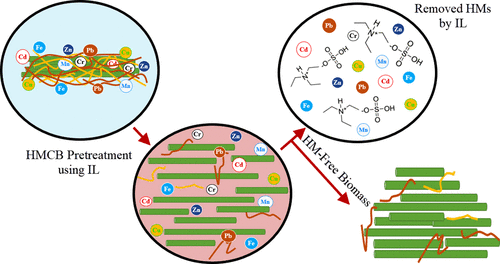当前位置:
X-MOL 学术
›
ACS Sustain. Chem. Eng.
›
论文详情
Our official English website, www.x-mol.net, welcomes your
feedback! (Note: you will need to create a separate account there.)
Effective Pretreatment of Heavy Metal-Contaminated Biomass Using a Low-Cost Ionic Liquid (Triethylammonium Hydrogen Sulfate): Optimization by Response Surface Methodology–Box Behnken Design
ACS Sustainable Chemistry & Engineering ( IF 7.1 ) Pub Date : 2019-05-15 00:00:00 , DOI: 10.1021/acssuschemeng.9b01457 Wafa Dastyar 1 , Ming Zhao 1, 2 , Wenyi Yuan 3 , Hui Li 4 , Zhao Jia Ting 1 , Hosein Ghaedi 1 , Hairong Yuan 5 , Xiujin Li 5 , Wei Wang 1, 2
ACS Sustainable Chemistry & Engineering ( IF 7.1 ) Pub Date : 2019-05-15 00:00:00 , DOI: 10.1021/acssuschemeng.9b01457 Wafa Dastyar 1 , Ming Zhao 1, 2 , Wenyi Yuan 3 , Hui Li 4 , Zhao Jia Ting 1 , Hosein Ghaedi 1 , Hairong Yuan 5 , Xiujin Li 5 , Wei Wang 1, 2
Affiliation

|
Recently, dealing with generated heavy metal-contaminated biomasses (HMCBs) harvested from phytoextraction process has drawn increasing attention. In this study, the feasibility of an HMCB (willow) pretreatment using a low-cost ionic liquid (IL), namely, triethylammonium hydrogen sulfate [TEA][HSO4], is investigated to remove the high contents of HMs prior to further thermochemical and biological valorization. The operating variables were temperature (75–105 °C), IL:biomass (10:1–30:1) ratio, and time (4–8 h) with constant feedstock particle size (0.35 mm). According to results obtained from response surface methodology–Box Behnken design (RSM–BBD), the optimum conditions of the IL-based pretreatment of HMCB for maximum HMs’ removal are temperature, 93 °C; IL:biomass ratio, 30:1; and time, 7.12 h. Under the optimum conditions, the IL is found to solubilize lignin and hemicellulose respectively about 70.54% and 92.56%; and subsequently, effective removal of HMs from HMCB is obtained (Cu, 100%; Zn, 88.77%; Mn, 79.70%; Fe, 73.11%; Cd, 70.42%; Al, 34.53%; and Cr, 18.17%), while Pb removal is negligible. The average amount of confidence intervals of developed models is ∼95%, and generally, the ratio of IL:biomass shows a higher effect on the efficiency of biomass fractionation and HMs’ removal, compared with temperature and time; however, interactions between the operating parameters are negligible.
中文翻译:

使用低成本离子液体(硫酸三乙铵氢盐)对重金属污染的生物质进行有效的预处理:通过响应面方法进行优化–盒式Behnken设计
近来,处理从植物提取过程中收获的重金属污染的生物质(HMCBs)已引起越来越多的关注。在这项研究中,使用低成本离子液体(IL),即硫酸三乙铵[TEA] [HSO 4 ]进行HMCB(柳树)预处理的可行性进行了研究,以在进一步热化学和生物增值之前除去高含量的HM。操作变量为温度(75–105°C),IL:生物质(10:1–30:1)比率和时间(4–8 h),且原料颗粒尺寸(0.35 mm)恒定。根据响应表面方法Box-Behnken设计(RSM-BBD)获得的结果,以IL为基础进行HMCB预处理以最大程度地去除HMs的最佳条件是温度为93°C。IL:生物质比为30:1;和时间,7.12小时。在最佳条件下,发现白细胞介素可分别溶解木质素和半纤维素约70.54%和92.56%。然后从HMCB中有效去除HMs(Cu,100%; Zn,88.77%; Mn,79.70%; Fe,73.11%; Cd,70.42%; Al,34.53%;和Cr,18.17%),而铅的去除可以忽略不计。所开发模型的平均置信区间约为95%,并且与温度和时间相比,IL:生物质的比例通常对生物质分离效率和HMs的去除效果更高;但是,运行参数之间的相互作用可以忽略不计。
更新日期:2019-05-15
中文翻译:

使用低成本离子液体(硫酸三乙铵氢盐)对重金属污染的生物质进行有效的预处理:通过响应面方法进行优化–盒式Behnken设计
近来,处理从植物提取过程中收获的重金属污染的生物质(HMCBs)已引起越来越多的关注。在这项研究中,使用低成本离子液体(IL),即硫酸三乙铵[TEA] [HSO 4 ]进行HMCB(柳树)预处理的可行性进行了研究,以在进一步热化学和生物增值之前除去高含量的HM。操作变量为温度(75–105°C),IL:生物质(10:1–30:1)比率和时间(4–8 h),且原料颗粒尺寸(0.35 mm)恒定。根据响应表面方法Box-Behnken设计(RSM-BBD)获得的结果,以IL为基础进行HMCB预处理以最大程度地去除HMs的最佳条件是温度为93°C。IL:生物质比为30:1;和时间,7.12小时。在最佳条件下,发现白细胞介素可分别溶解木质素和半纤维素约70.54%和92.56%。然后从HMCB中有效去除HMs(Cu,100%; Zn,88.77%; Mn,79.70%; Fe,73.11%; Cd,70.42%; Al,34.53%;和Cr,18.17%),而铅的去除可以忽略不计。所开发模型的平均置信区间约为95%,并且与温度和时间相比,IL:生物质的比例通常对生物质分离效率和HMs的去除效果更高;但是,运行参数之间的相互作用可以忽略不计。















































 京公网安备 11010802027423号
京公网安备 11010802027423号